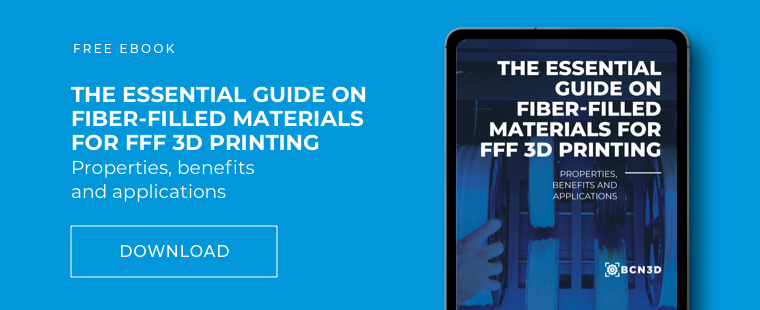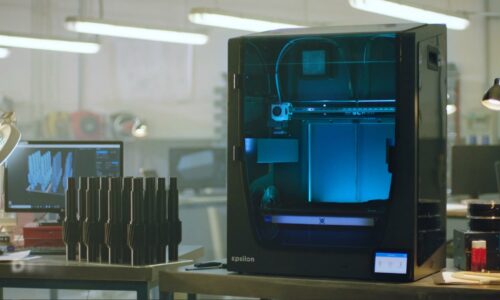Strongest 3D Printing Materials: Impact Resistant Filaments
If you need to 3D print a part or object that has to withstand high impact or repetitive use, you’ll have to turn to some of the strongest 3D printing materials.
What makes a 3D printing filament strong? In this article, strength refers to materials that are able to withstand high impact and repeated use, and are durable. Some filaments have higher impact resistance, some better fatigue resistance or durability, and some have a combination of all three factors.
In this article, we’re reviewing 7 of the strongest 3D printing materials and how to choose between them for your next print.
7 Strongest 3D Printing Materials
The strongest 3D printing filaments are:
- ABS
- TPU
- PET-G
- PA
- PAHT CF15
- PP
- PP GF30.
The strength of these filaments vary, as some are more impact resistant, while others are structurally strong or even fatigue resistant. Let’s dive into the unique characteristics of each filament.
1. ABS
ABS (acrylonitrile butadiene styrene) is a stiff and impact-resistant thermoplastic material. It is a popular material that is mostly used for engineering purposes and technical prints. Compared to many other fiber filaments ABS is quite cost-effective, making it a great choice if you’re on a budget yet still need high strength. Along with being durable against impact and fatigue, ABS is also heat resistant and water-resistant.
- When To Choose ABS:
ABS is the perfect 3D printing material to use if your print will be used for a moving part, high mechanical stress, or for high-stress functionality. ABS is also a good option if your print will be an end-use product, as it has an attractive surface finish.
2. TPU
TPU (Thermoplastic polyurethane) is most well known for its flexibility, which is what makes this 3D printing material so strong. Along with being flexible, TPU is also highly durable, with strong resistance to impact, wear and tear, chemicals, and abrasion. TPU is an ideal 3D printing material to use for shock absorption.
- When to Choose TPU:
With the ability to extend up to 4.5 times its original size without breaking, TPU is your go-to choice for any prints that require high levels of flexibility and strength. TPU is commonly used to print parts like wheels, springs, shock absorbers, and other flexible objects.
3. PET-G
3D printing beginners should turn to PET-G (Polyethylene terephthalate glycol-modified) when looking for a 3D printing material that is both strong and easy to print. PET-G is easier to print than ABS, yet stronger and more technical than PLA. PET-G is impact-resistant, abrasion-resistant, and also features some flexibility.
- When to Choose PET-G:
Featuring a shiny finish and good levels of strength, PET-G is a great option for end-use parts. It is commonly used to print functional prototypes, mild-stress parts, and protective cases.
4. PA
One of the strongest 3D printing materials in terms of durability and heat resistance is PA (Polyamide). This semicrystalline plastic is used for prints that will undergo heavy-duty applications. PA has high strength, excellent impact resistance, and is fatigue-resistant, making it ideal for moving parts.
- When To Choose PA:
PA is commonly used to create washers, gears, jigs, sliding parts, and objects that undergo high fatigue. As one of the strongest 3D printing materials, it is resistant to abrasion, impact, and heat. When compared to ABS, PA has better impact strength and flexibility.
5. PAHT CF15
Another commonly used 3D printing material in the automotive industry is PAHT CF15 (High-Temperature Polyamide carbon fiber reinforced.) This filament packs a punch and it is the strongest 3D printing material on our list. PAHT CF15 is characterized by high levels of strength, heat resistance, stiffness, and impact resistance.
- When to Choose PAHT CF15:
Although it can be tempting to want to instantly use the strongest material you can find, this isn’t always the right choice. This strong 3D printing filament is best suited for the most demanding objects or parts. Reach for it when you need a material that needs to replace metal, or parts that will undergo extreme temperatures and high-stress environments.
6. PP
PP (Polypropylene) is a lightweight and flexible material, but don’t let that fool you. In fact, PP is a very durable 3D printing material with great impact and fatigue resistance. PP is most well known for its heavy-duty resistance to most chemicals, including alkali, acids, and organic solvents.
- When to Choose PP:
While its lightweight nature may not make it as strong as other filaments on this list, its durability and resistance to impact while also maintaining an airy quality still make it a good option for parts that will undergo repetitive applications, such as packaging, pipes, and joints.
7. PP GF30
PP GF30 (polypropylene 30% glass fiber) is like PP, but with a little extra boost. The glass fiber in PP GF30 allows this 3D printing material to have high levels of strength and rigidity while maintaining its lightness and high chemical resistance. This is one of the strongest 3D printing materials, and it is frequently used in the automotive and aerospace industries.
- When to Choose PP GF30:
Along with being lightweight, durable, and stiff, one of PP GF30’s most impressive qualities is its high resistance to hostile environments, including chemicals and weather conditions. If your 3D print will be placed outside or need to withstand harsh temperatures while maintaining structural strength, then PP GF30 will be a great choice.
Conclusion
The strongest 3D printer filament comes in all shapes, sizes, and definitions of strength. Whether you’re looking for durability, impact resistance, or fatigue resistance, this list is sure to lead you in the right direction.




